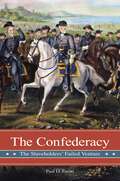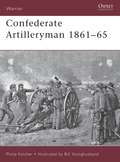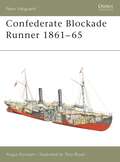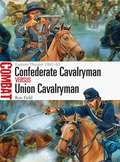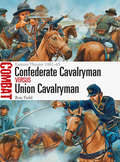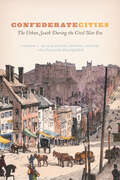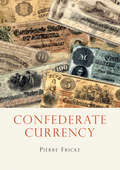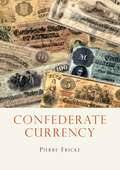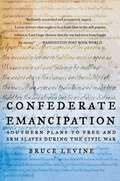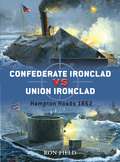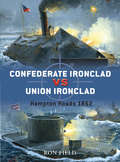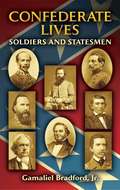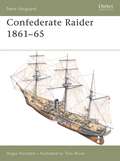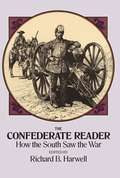- Table View
- List View
The Confederacy: The Slaveholders' Failed Venture (Reflections on the Civil War Era)
by Paul D. EscottA sharp-edged and revealing account of the transforming struggle for Southern independence and the inherent contradictions that undermined that effort.Paul Escott's The Confederacy: The Slaveholders' Failed Venture offers a unique and multifaceted perspective on the United States' most pivotal and devastating conflict, examining the course of the Civil War from the perspective of the Southern elite class, who were desperate to preserve the "peculiar institution" of its slave-based economy, yet dependent on ordinary Southerners, slaves, and women to sustain the fight for them.Against the backdrop of the war's military drama and strategic dilemmas, The Confederacy brings into sharp focus the racial, class, gender, and political conflicts that helped destabilize the Confederacy from within. Along the way, Escott shows how time and time again, the South's political and economic elite made errors that further weakened a South already facing a Union army with greater numbers and firepower.
The Confederacy: The Slaveholders' Failed Venture (Reflections on the Civil War Era)
by Paul D. EscottA sharp-edged and revealing account of the transforming struggle for Southern independence and the inherent contradictions that undermined that effort.Paul Escott's The Confederacy: The Slaveholders' Failed Venture offers a unique and multifaceted perspective on the United States' most pivotal and devastating conflict, examining the course of the Civil War from the perspective of the Southern elite class, who were desperate to preserve the "peculiar institution" of its slave-based economy, yet dependent on ordinary Southerners, slaves, and women to sustain the fight for them.Against the backdrop of the war's military drama and strategic dilemmas, The Confederacy brings into sharp focus the racial, class, gender, and political conflicts that helped destabilize the Confederacy from within. Along the way, Escott shows how time and time again, the South's political and economic elite made errors that further weakened a South already facing a Union army with greater numbers and firepower.
Confederate Artilleryman 1861–65 (Warrior)
by Bill Younghusband Philip KatcherIn the heady days of the rush to arms in 1861, comparatively few Southern men volunteered for service in the artillery: most preferred the easily accessible glory of the infantry or cavalry. Yet those that did quickly earned the respect of their fellow soldiers, and a reputation for being able to "pull through deeper mud, ford deeper springs, shoot faster, swear louder ... than any other class of men in the service". Given that field artillery was invariably deployed in front of the troops that it was supporting, the artillerymen were exposed to a high level of enemy fire, and losses were significant. This title guides the reader through the life and experiences of the Confederate cannoneer where he came from; how he trained and lived; how he dressed, ate and was equipped; and how he fought.
Confederate Artilleryman 1861–65 (Warrior #34)
by Bill Younghusband Philip KatcherIn the heady days of the rush to arms in 1861, comparatively few Southern men volunteered for service in the artillery: most preferred the easily accessible glory of the infantry or cavalry. Yet those that did quickly earned the respect of their fellow soldiers, and a reputation for being able to "pull through deeper mud, ford deeper springs, shoot faster, swear louder ... than any other class of men in the service". Given that field artillery was invariably deployed in front of the troops that it was supporting, the artillerymen were exposed to a high level of enemy fire, and losses were significant. This title guides the reader through the life and experiences of the Confederate cannoneer where he came from; how he trained and lived; how he dressed, ate and was equipped; and how he fought.
The Confederate Battle Flag: America's Most Embattled Emblem
by John M. CoskiIn recent years, the Confederate flag has become as much a news item as a Civil War relic. Intense public debates have erupted over Confederate flags flying atop state capitols, being incorporated into state flags, waving from dormitory windows, or adorning the T-shirts and jeans of public school children. To some, this piece of cloth is a symbol of white supremacy and enduring racial injustice; to others, it represents a rich Southern heritage and an essential link to a glorious past. Polarizing Americans, these "flag wars" reveal the profound--and still unhealed--schisms that have plagued the country since the Civil War. The Confederate Battle Flag is the first comprehensive history of this contested symbol. Transcending conventional partisanship, John Coski reveals the flag's origins as one of many banners unfurled on the battlefields of the Civil War. He shows how it emerged as the preeminent representation of the Confederacy and was transformed into a cultural icon from Reconstruction on, becoming an aggressively racist symbol only after World War II and during the Civil Rights movement. We gain unique insight into the fine line between the flag's use as a historical emblem and as an invocation of the Confederate nation and all it stood for. Pursuing the flag's conflicting meanings, Coski suggests how this provocative artifact, which has been viewed with pride, fear, anger, nostalgia, and disgust, might ultimately provide Americans with the common ground of a shared and complex history.
Confederate Blockade Runner 1861–65 (New Vanguard)
by Angus KonstamThe lifeblood of the Confederacy, the blockade runners of the Civil War usually began life as regular fast steam-powered merchant ships. They were adapted for the high-speed dashes through the Union blockade which closed off all the major Southern ports, and for much of the war they brought much-needed food, clothing and weaponry to the Confederacy. This book traces their operational history, including the development of purpose-built blockade running ships, and examines their engines, crews and tactics. It describes their wartime exploits, demonstrating their operational and mechanical performance, whilst examining what life was like on these vessels through accounts of conditions on board when they sailed into action.
Confederate Blockade Runner 1861–65 (New Vanguard)
by Angus KonstamThe lifeblood of the Confederacy, the blockade runners of the Civil War usually began life as regular fast steam-powered merchant ships. They were adapted for the high-speed dashes through the Union blockade which closed off all the major Southern ports, and for much of the war they brought much-needed food, clothing and weaponry to the Confederacy. This book traces their operational history, including the development of purpose-built blockade running ships, and examines their engines, crews and tactics. It describes their wartime exploits, demonstrating their operational and mechanical performance, whilst examining what life was like on these vessels through accounts of conditions on board when they sailed into action.
Confederate Cavalryman vs Union Cavalryman: Eastern Theater 1861–65 (Combat)
by Peter Dennis Ron FieldDuring the intense, sprawling conflict that was the American Civil War, both Union and Confederate forces fielded substantial numbers of cavalry, which carried out the crucial tasks of reconnaissance, raiding, and conveying messages. The perception was that cavalry's effectiveness on the battlefield would be drastically reduced in this age of improved infantry firearms. This title, however, demonstrates how cavalry's lethal combination of mobility and dismounted firepower meant it was still very much a force to be reckoned with in battle, and charts the swing in the qualitative difference of the cavalry forces fielded by the two sides as the war progressed. In this book, three fierce cavalry actions of the American Civil War are assessed, including the battles of Second Bull Run/Manassas (1862), Buckland Mills (1863) and Tom's Brook (1864).
Confederate Cavalryman vs Union Cavalryman: Eastern Theater 1861–65 (Combat)
by Peter Dennis Ron FieldDuring the intense, sprawling conflict that was the American Civil War, both Union and Confederate forces fielded substantial numbers of cavalry, which carried out the crucial tasks of reconnaissance, raiding, and conveying messages. The perception was that cavalry's effectiveness on the battlefield would be drastically reduced in this age of improved infantry firearms. This title, however, demonstrates how cavalry's lethal combination of mobility and dismounted firepower meant it was still very much a force to be reckoned with in battle, and charts the swing in the qualitative difference of the cavalry forces fielded by the two sides as the war progressed. In this book, three fierce cavalry actions of the American Civil War are assessed, including the battles of Second Bull Run/Manassas (1862), Buckland Mills (1863) and Tom's Brook (1864).
Confederate Cities: The Urban South during the Civil War Era (Historical Studies of Urban America)
by Andrew L. Slap and Frank Towers Frank TowersWhen we talk about the Civil War, we often describe it in terms of battles that took place in small towns or in the countryside: Antietam, Gettysburg, Bull Run, and, most tellingly, the Battle of the Wilderness. One reason this picture has persisted is that few urban historians have studied the war, even though cities hosted, enabled, and shaped Southern society as much as they did in the North. Confederate Cities, edited by Andrew L. Slap and Frank Towers, shifts the focus from the agrarian economy that undergirded the South to the cities that served as its political and administrative hubs. The contributors use the lens of the city to examine now-familiar Civil War–era themes, including the scope of the war, secession, gender, emancipation, and war’s destruction. This more integrative approach dramatically revises our understanding of slavery’s relationship to capitalist economics and cultural modernity. By enabling a more holistic reading of the South, the book speaks to contemporary Civil War scholars and students alike—not least in providing fresh perspectives on a well-studied war.
Confederate Cities: The Urban South during the Civil War Era (Historical Studies of Urban America)
by Andrew L. Slap and Frank Towers Frank TowersWhen we talk about the Civil War, we often describe it in terms of battles that took place in small towns or in the countryside: Antietam, Gettysburg, Bull Run, and, most tellingly, the Battle of the Wilderness. One reason this picture has persisted is that few urban historians have studied the war, even though cities hosted, enabled, and shaped Southern society as much as they did in the North. Confederate Cities, edited by Andrew L. Slap and Frank Towers, shifts the focus from the agrarian economy that undergirded the South to the cities that served as its political and administrative hubs. The contributors use the lens of the city to examine now-familiar Civil War–era themes, including the scope of the war, secession, gender, emancipation, and war’s destruction. This more integrative approach dramatically revises our understanding of slavery’s relationship to capitalist economics and cultural modernity. By enabling a more holistic reading of the South, the book speaks to contemporary Civil War scholars and students alike—not least in providing fresh perspectives on a well-studied war.
Confederate Cities: The Urban South during the Civil War Era (Historical Studies of Urban America)
by Andrew L. Slap and Frank Towers Frank TowersWhen we talk about the Civil War, we often describe it in terms of battles that took place in small towns or in the countryside: Antietam, Gettysburg, Bull Run, and, most tellingly, the Battle of the Wilderness. One reason this picture has persisted is that few urban historians have studied the war, even though cities hosted, enabled, and shaped Southern society as much as they did in the North. Confederate Cities, edited by Andrew L. Slap and Frank Towers, shifts the focus from the agrarian economy that undergirded the South to the cities that served as its political and administrative hubs. The contributors use the lens of the city to examine now-familiar Civil War–era themes, including the scope of the war, secession, gender, emancipation, and war’s destruction. This more integrative approach dramatically revises our understanding of slavery’s relationship to capitalist economics and cultural modernity. By enabling a more holistic reading of the South, the book speaks to contemporary Civil War scholars and students alike—not least in providing fresh perspectives on a well-studied war.
Confederate Cities: The Urban South during the Civil War Era (Historical Studies of Urban America)
by Andrew L. Slap Frank Towers David GoldfieldWhen we talk about the Civil War, we often describe it in terms of battles that took place in small towns or in the countryside: Antietam, Gettysburg, Bull Run, and, most tellingly, the Battle of the Wilderness. One reason this picture has persisted is that few urban historians have studied the war, even though cities hosted, enabled, and shaped Southern society as much as they did in the North. Confederate Cities, edited by Andrew L. Slap and Frank Towers, shifts the focus from the agrarian economy that undergirded the South to the cities that served as its political and administrative hubs. The contributors use the lens of the city to examine now-familiar Civil War–era themes, including the scope of the war, secession, gender, emancipation, and war’s destruction. This more integrative approach dramatically revises our understanding of slavery’s relationship to capitalist economics and cultural modernity. By enabling a more holistic reading of the South, the book speaks to contemporary Civil War scholars and students alike—not least in providing fresh perspectives on a well-studied war.
Confederate Cities: The Urban South during the Civil War Era (Historical Studies of Urban America)
by Andrew L. Slap Frank Towers Michael Goldfield David GoldfieldWhen we talk about the Civil War, we often describe it in terms of battles that took place in small towns or in the countryside: Antietam, Gettysburg, Bull Run, and, most tellingly, the Battle of the Wilderness. One reason this picture has persisted is that few urban historians have studied the war, even though cities hosted, enabled, and shaped Southern society as much as they did in the North. Confederate Cities, edited by Andrew L. Slap and Frank Towers, shifts the focus from the agrarian economy that undergirded the South to the cities that served as its political and administrative hubs. The contributors use the lens of the city to examine now-familiar Civil War–era themes, including the scope of the war, secession, gender, emancipation, and war’s destruction. This more integrative approach dramatically revises our understanding of slavery’s relationship to capitalist economics and cultural modernity. By enabling a more holistic reading of the South, the book speaks to contemporary Civil War scholars and students alike—not least in providing fresh perspectives on a well-studied war.
Confederate Cities: The Urban South during the Civil War Era (Historical Studies of Urban America)
by Andrew Slap Frank Towers David GoldfieldWhen we talk about the Civil War, we often describe it in terms of battles that took place in small towns or in the countryside: Antietam, Gettysburg, Bull Run, and, most tellingly, the Battle of the Wilderness. One reason this picture has persisted is that few urban historians have studied the war, even though cities hosted, enabled, and shaped Southern society as much as they did in the North. Confederate Cities, edited by Andrew L. Slap and Frank Towers, shifts the focus from the agrarian economy that undergirded the South to the cities that served as its political and administrative hubs. The contributors use the lens of the city to examine now-familiar Civil War–era themes, including the scope of the war, secession, gender, emancipation, and war’s destruction. This more integrative approach dramatically revises our understanding of slavery’s relationship to capitalist economics and cultural modernity. By enabling a more holistic reading of the South, the book speaks to contemporary Civil War scholars and students alike—not least in providing fresh perspectives on a well-studied war.
Confederate Currency (Shire Library USA #655)
by Pierre FrickeOn February 4, 1861, the Confederate States of America was formed, and almost immediately the first Confederate notes were printed – the famous "Montgomery†? notes. These would be followed by many designs over the next four years. The seventy different designs or "type†? notes are eagerly sought today by collectors, historians and family historians, and a collection of Confederate currency offers fascinating insights into the tumultuous Civil-War period. Pierre Fricke examines these series of Confederate notes, highlighting the history and circumstances in which they were created. This easy-to-read, fun and educational book offers an introduction to the often beautiful notes that financed the Confederacy.
Confederate Currency (Shire Library USA)
by Pierre FrickeOn February 4, 1861, the Confederate States of America was formed, and almost immediately the first Confederate notes were printed – the famous "Montgomery†? notes. These would be followed by many designs over the next four years. The seventy different designs or "type†? notes are eagerly sought today by collectors, historians and family historians, and a collection of Confederate currency offers fascinating insights into the tumultuous Civil-War period. Pierre Fricke examines these series of Confederate notes, highlighting the history and circumstances in which they were created. This easy-to-read, fun and educational book offers an introduction to the often beautiful notes that financed the Confederacy.
Confederate Emancipation: Southern Plans to Free and Arm Slaves during the Civil War
by Bruce LevineIn early 1864, as the Confederate Army of Tennessee licked its wounds after being routed at the Battle of Chattanooga, Major-General Patrick Cleburne (the "Stonewall of the West") proposed that "the most courageous of our slaves" be trained as soldiers and that "every slave in the South who shall remain true to the Confederacy in this war" be freed. In Confederate Emancipation, Bruce Levine looks closely at such Confederate plans to arm and free slaves. He shows that within a year of Cleburne's proposal, which was initially rejected out of hand, Jefferson Davis, Judah P. Benjamin, and Robert E. Lee had all reached the same conclusions. At that point, the idea was debated widely in newspapers and drawing rooms across the South, as more and more slaves fled to Union lines and fought in the ranks of the Union army. Eventually, the soldiers of Lee's army voted on the proposal, and the Confederate government actually enacted a version of it in March. The Army issued the necessary orders just two weeks before Appomattox, too late to affect the course of the war. Throughout the book, Levine captures the voices of blacks and whites, wealthy planters and poor farmers, soldiers and officers, and newspaper editors and politicians from all across the South. In the process, he sheds light on such hot-button topics as what the Confederacy was fighting for, whether black southerners were willing to fight in large numbers in defense of the South, and what this episode foretold about life and politics in the post-war South. Confederate Emancipation offers an engaging and illuminating account of a fascinating and politically charged idea, setting it firmly and vividly in the context of the Civil War and the part played in it by the issue of slavery and the actions of the slaves themselves.
Confederate Emancipation: Southern Plans to Free and Arm Slaves during the Civil War
by Bruce LevineIn early 1864, as the Confederate Army of Tennessee licked its wounds after being routed at the Battle of Chattanooga, Major-General Patrick Cleburne (the "Stonewall of the West") proposed that "the most courageous of our slaves" be trained as soldiers and that "every slave in the South who shall remain true to the Confederacy in this war" be freed. In Confederate Emancipation, Bruce Levine looks closely at such Confederate plans to arm and free slaves. He shows that within a year of Cleburne's proposal, which was initially rejected out of hand, Jefferson Davis, Judah P. Benjamin, and Robert E. Lee had all reached the same conclusions. At that point, the idea was debated widely in newspapers and drawing rooms across the South, as more and more slaves fled to Union lines and fought in the ranks of the Union army. Eventually, the soldiers of Lee's army voted on the proposal, and the Confederate government actually enacted a version of it in March. The Army issued the necessary orders just two weeks before Appomattox, too late to affect the course of the war. Throughout the book, Levine captures the voices of blacks and whites, wealthy planters and poor farmers, soldiers and officers, and newspaper editors and politicians from all across the South. In the process, he sheds light on such hot-button topics as what the Confederacy was fighting for, whether black southerners were willing to fight in large numbers in defense of the South, and what this episode foretold about life and politics in the post-war South. Confederate Emancipation offers an engaging and illuminating account of a fascinating and politically charged idea, setting it firmly and vividly in the context of the Civil War and the part played in it by the issue of slavery and the actions of the slaves themselves.
Confederate Ironclad vs Union Ironclad: Hampton Roads 1862 (Duel)
by Howard Gerrard Peter Bull Ron FieldThe Ironclad was a revolutionary weapon of war, the first modern, armoured, self-propelled warships. During the American Civil War the South used ironclads to protect their ports from the Northern blockade. Impressed with their superior resistance to fire and, the North developed its own rival fleet of ironclads. Eventually the two products of this modern arms race duelled at the battle of Hampton Roads in a clash that would change the face of naval warfare. Fully illustrated with cutting-edge digital artwork, rare photographs and first-person perspective gunsight views, this book allows the reader to discover the revolutionary and radically different designs of the two rival Ironclads – the Merrimac and USS Monitor – through an analysis of each ship's weaponry, ammunition and steerage.
Confederate Ironclad vs Union Ironclad: Hampton Roads 1862 (Duel #14)
by Howard Gerrard Peter Bull Ron FieldALSO AVAILABLE TO BUY AS AN E-BOOK. The Ironclad was a revolutionary weapon of war, the first modern, armoured, self-propelled warships. During the American Civil War the South used ironclads to protect their ports from the Northern blockade. Impressed with their superior resistance to fire and, the North developed its own rival fleet of ironclads. Eventually the two products of this modern arms race duelled at the battle of Hampton Roads in a clash that would change the face of naval warfare. Fully illustrated with cutting-edge digital artwork, rare photographs and first-person perspective gunsight views, this book allows the reader to discover the revolutionary and radically different designs of the two rival Ironclads – the Merrimac and USS Monitor – through an analysis of each ship's weaponry, ammunition and steerage.
Confederate Lives: Soldiers and Statesmen (Civil War)
by Gamaliel BradfordThe distinguished historian Gamaliel Bradford, Jr.--author of Lee, the American and other acclaimed Civil War biographies--offers portraits of eight key leaders of the Confederacy. Bradford's skills at compiling concise profiles are at their finest in these compelling sketches of prominent figures in the Southern Cause.Commanding officers include Joseph E. Johnston, the highest-ranking U.S. Army officer to resign and join the Confederacy; the war's most famous cavalryman, J. E. B. Stuart; Lee's "Old War Horse," James Longstreet, who served from Manassas to Appomattox; P. G. T. Beauregard, winner of the nearly bloodless victory at Fort Sumter; and Rear Admiral Raphael Semmes, so successful in battle that he was charged at the war's end with treason and piracy. Confederate statesmen include U.S. Senator Judah P. Benjamin, appointed by Jefferson Davis as Confederate attorney general, secretary of war, and secretary of state; Vice-President of the Confederate States, Alexander H. Stephens; and Senator Robert Toombs, who evolved from conservative Unionist to ardent secessionist.The book concludes with the "high water mark" of the Confederacy at Gettysburg and examines the effects of that momentous battle. Previously available only in expensive, hard-to-find editions, this volume is a rare find for Civil War buffs.
Confederate Raider 1861–65 (New Vanguard)
by Angus KonstamThe Confederate states adopted radical solutions to counter the naval superiority of their opponents. One of the more successful solutions they adopted was the use of commerce raiders. This book describes the reasons which forced the Confederates to resort to commerce raiding, and outlines the way in which these craft were converted or specially built to perform their role. It details not only the way these craft were operated and manned, but also their brutal attacks, daring escapes and climatic battles against the large numbers of Union warships forced to hunt them down.
Confederate Raider 1861–65 (New Vanguard)
by Angus KonstamThe Confederate states adopted radical solutions to counter the naval superiority of their opponents. One of the more successful solutions they adopted was the use of commerce raiders. This book describes the reasons which forced the Confederates to resort to commerce raiding, and outlines the way in which these craft were converted or specially built to perform their role. It details not only the way these craft were operated and manned, but also their brutal attacks, daring escapes and climatic battles against the large numbers of Union warships forced to hunt them down.
The Confederate Reader: How the South Saw the War (Civil War Ser.)
by Richard B. HarwellFor any student of the War Between the States, this treasury of contemporary documents—all but a few written by Southerners — offers a wealth of insight and perspectives on life in the South during the conflict, how newspapers and periodicals covered events, and how Southerners reacted to the disastrous struggle that disrupted their lives and ravaged their homes, farms, and cities. Selections have been arranged in an order that demonstrates the progress of the war, beginning with a South Carolina ordinance to secede from the Union and ending with a final message in 1865 from the last Confederate general to surrender. Relive the day-to-day reality of the War as captured in a rich legacy of written records: official battle reports, general orders, letters, sermons, songs, published articles, novels, and accounts of travel, prison, and conditions of army life. Included are contemporary newspaper accounts of the Battle of Fort Sumter, a stirring address to his soldiers by Jefferson Davis in 1864, a Confederate prisoner's account of life in a Yankee prison, a newspaper report of the sack and destruction of Columbia, South Carolina, a poignant last-ditch attempt by General E. Kirby Smith in 1865 to rally the Trans-Mississippi Army, and many more. A selection of authentic cartoons, sketches, and broadsides from various periods of the War adds a special "you-are-there" flavor to the book. Carefully chosen and annotated by a distinguished authority on the Confederacy, these selections paint a broad and moving picture of the attitudes, emotions, and ideas that motivated and sustained the South during the War. Assembled in this inexpensive paperback edition of The Confederate Reader, they will bring new insight and enlightenment to any Civil War buff or student of American history.
